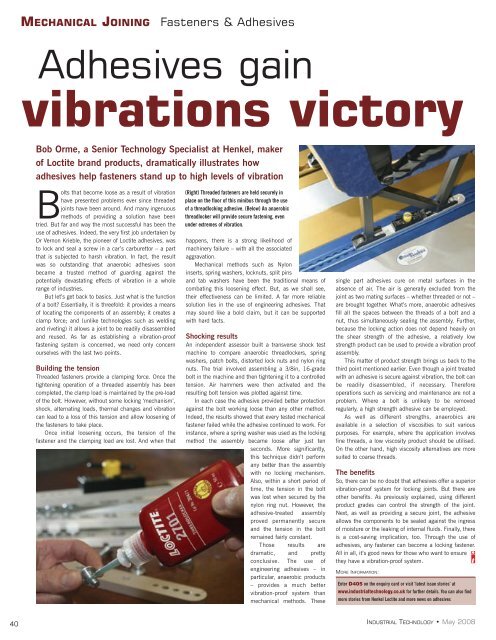sensors & systems - Industrial Technology Magazine
sensors & systems - Industrial Technology Magazine
sensors & systems - Industrial Technology Magazine
Create successful ePaper yourself
Turn your PDF publications into a flip-book with our unique Google optimized e-Paper software.
MECHANICAL JOINING<br />
Fasteners & Adhesives<br />
Adhesives gain<br />
vibrations victory<br />
Bob Orme, a Senior <strong>Technology</strong> Specialist at Henkel, maker<br />
of Loctite brand products, dramatically illustrates how<br />
adhesives help fasteners stand up to high levels of vibration<br />
Bolts that become loose as a result of vibration<br />
have presented problems ever since threaded<br />
joints have been around. And many ingenuous<br />
methods of providing a solution have been<br />
tried. But far and way the most successful has been the<br />
use of adhesives. Indeed, the very first job undertaken by<br />
Dr Vernon Krieble, the pioneer of Loctite adhesives, was<br />
to lock and seal a screw in a car’s carburettor – a part<br />
that is subjected to harsh vibration. In fact, the result<br />
was so outstanding that anaerobic adhesives soon<br />
became a trusted method of guarding against the<br />
potentially devastating effects of vibration in a whole<br />
range of industries.<br />
But let’s get back to basics. Just what is the function<br />
of a bolt? Essentially, it is threefold: it provides a means<br />
of locating the components of an assembly; it creates a<br />
clamp force; and (unlike technologies such as welding<br />
and riveting) it allows a joint to be readily disassembled<br />
and reused. As far as establishing a vibration-proof<br />
fastening system is concerned, we need only concern<br />
ourselves with the last two points.<br />
Building the tension<br />
Threaded fasteners provide a clamping force. Once the<br />
tightening operation of a threaded assembly has been<br />
completed, the clamp load is maintained by the pre-load<br />
of the bolt. However, without some locking ‘mechanism’,<br />
shock, alternating loads, thermal changes and vibration<br />
can lead to a loss of this tension and allow loosening of<br />
the fasteners to take place.<br />
Once initial loosening occurs, the tension of the<br />
fastener and the clamping load are lost. And when that<br />
(Right) Threaded fasteners are held securely in<br />
place on the floor of this minibus through the use<br />
of a threadlocking adhesive. (Below) An anaerobic<br />
threadlocker will provide secure fastening, even<br />
under extremes of vibration.<br />
happens, there is a strong likelihood of<br />
machinery failure – with all the associated<br />
aggravation.<br />
Mechanical methods such as Nylon<br />
inserts, spring washers, locknuts, split pins<br />
and tab washers have been the traditional means of<br />
combating this loosening effect. But, as we shall see,<br />
their effectiveness can be limited. A far more reliable<br />
solution lies in the use of engineering adhesives. That<br />
may sound like a bold claim, but it can be supported<br />
with hard facts.<br />
Shocking results<br />
An independent assessor built a transverse shock test<br />
machine to compare anaerobic threadlockers, spring<br />
washers, patch bolts, distorted lock nuts and nylon ring<br />
nuts. The trial involved assembling a 3/8in, 16-grade<br />
bolt in the machine and then tightening it to a controlled<br />
tension. Air hammers were then activated and the<br />
resulting bolt tension was plotted against time.<br />
In each case the adhesive provided better protection<br />
against the bolt working loose than any other method.<br />
Indeed, the results showed that every tested mechanical<br />
fastener failed while the adhesive continued to work. For<br />
instance, where a spring washer was used as the locking<br />
method the assembly became loose after just ten<br />
seconds. More significantly,<br />
this technique didn’t perform<br />
any better than the assembly<br />
with no locking mechanism.<br />
Also, within a short period of<br />
time, the tension in the bolt<br />
was lost when secured by the<br />
nylon ring nut. However, the<br />
adhesive-treated assembly<br />
proved permanently secure<br />
and the tension in the bolt<br />
remained fairly constant.<br />
Those results are<br />
dramatic, and pretty<br />
conclusive. The use of<br />
engineering adhesives – in<br />
particular, anaerobic products<br />
– provides a much better<br />
vibration-proof system than<br />
mechanical methods. These<br />
single part adhesives cure on metal surfaces in the<br />
absence of air. The air is generally excluded from the<br />
joint as two mating surfaces – whether threaded or not –<br />
are brought together. What’s more, anaerobic adhesives<br />
fill all the spaces between the threads of a bolt and a<br />
nut, thus simultaneously sealing the assembly. Further,<br />
because the locking action does not depend heavily on<br />
the shear strength of the adhesive, a relatively low<br />
strength product can be used to provide a vibration proof<br />
assembly.<br />
This matter of product strength brings us back to the<br />
third point mentioned earlier. Even though a joint treated<br />
with an adhesive is secure against vibration, the bolt can<br />
be readily disassembled, if necessary. Therefore<br />
operations such as servicing and maintenance are not a<br />
problem. Where a bolt is unlikely to be removed<br />
regularly, a high strength adhesive can be employed.<br />
As well as different strengths, anaerobics are<br />
available in a selection of viscosities to suit various<br />
purposes. For example, where the application involves<br />
fine threads, a low viscosity product should be utilised.<br />
On the other hand, high viscosity alternatives are more<br />
suited to coarse threads.<br />
The benefits<br />
So, there can be no doubt that adhesives offer a superior<br />
vibration-proof system for locking joints. But there are<br />
other benefits. As previously explained, using different<br />
product grades can control the strength of the joint.<br />
Next, as well as providing a secure joint, the adhesive<br />
allows the components to be sealed against the ingress<br />
of moisture or the leaking of internal fluids. Finally, there<br />
is a cost-saving implication, too. Through the use of<br />
adhesives, any fastener can become a locking fastener.<br />
All in all, it’s good news for those who want to ensure<br />
they have a vibration-proof system.<br />
MORE INFORMATION:<br />
Enter D405 on the enquiry card or visit ‘latest issue stories’ at<br />
www.industrialtechnology.co.uk for further details. You can also find<br />
more stories from Henkel Loctite and more news on adhesives<br />
40<br />
INDUSTRIAL TECHNOLOGY • May 2008
















